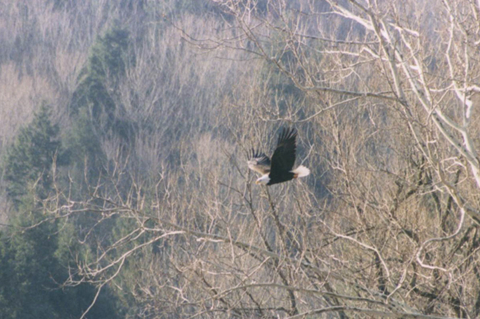
The Watershed Post is delighted to introduce our first columnist: Aaron Bennett of Catskill Mountainkeeper. Bennett’s job as regional director at CMK is to serve the “high peaks region” of the Catskill Mountains, which includes Delaware, Greene and Ulster counties. We’ll be featuring his column, View from the High Peaks, on a regular basis. If you’ve got a column idea for the Watershed Post, we’d like to hear from you, too. –Ed.
It seems as though winter has taken a hiatus here in the Catskill Mountains, but we are not in the clear yet. True, it is officially “spring,” and the opening day of trout fishing season – April 1st – is merely a week away, but there is still a large snowpack in the high peaks. Let’s hope that when it finally melts, it will recharge our groundwater supply rather than run off quickly into our trout streams. This ice-cold snowmelt that should slowly infiltrate the mountainsides is not only important for recharging our underground supply of drinking water throughout the drier summer months, but will also provide countless places of thermal refuge for the thousands of stressed-out trout that will need to seek cold, well-oxygenated water to survive.
Speaking of fish, I recently ventured over to the Pepacton Reservoir, fishing pole in hand, to see if I could find any open water near shore. I had noticed earlier in the week that most of the Ashokan Reservoir was already ice-free. Knowing that ice-out is usually several weeks later on the Pepacton, I knew I was rolling the dice, but figured I would be able to find something I’d like along the steeper, deeper southern shore.
About three miles below Margaretville, the ice still blanketed the entire water body. Only the upper mile or so of what I would call the “reservoir” had open water. I parked, gathered my gear, hiked through the woods over a small hemlock-covered hill, and then down the other side to the icy shore. The water level was quite high (94% capacity to be exact). I was able to find an open patch of forest where a small powerline cut provided the opening I needed to cast.
I was fishing for smallmouth bass. Admittedly, I know very little about bass fishing in general, let alone fishing for them in winter. Most importantly, I know the regulations – catch and release, and use of only artificial lures, this time of year. There was ice at the edge, and chunks of ice drifting by, but it was relatively easy to cast off the steep hillside, over the ice, and into a narrow channel in the reservoir.
 Fellow angler: A mature bald eagle takes flight along the Bush Kill in Arkville, a tributary to the East Branch Delaware River and the Pepacton Reservoir
Fellow angler: A mature bald eagle takes flight along the Bush Kill in Arkville, a tributary to the East Branch Delaware River and the Pepacton Reservoir
Across the way, I could see and hear the cars whizzing by on Route 30 between the reservoir and the slopes of Meekers Hill. After fishing for a half-hour with no luck, I moved to another open spot I found further “downstream.” Another angler had made a nice bench out of a weathered piece of lumber. It was the perfect place to spend the next hour, although I would not be fishing.
Instead, I was fixated on a pair of bald eagles flying to and from their nest. At first, I just saw one swooping into a tall white pine along the far side of the reservoir. I watched it as best as I could without a pair of binoculars (lesson learned). It took off, flew around, and then returned. Then, another one coming downstream caught my eye, drifting around the upper ridge of Meekers Hill. The people in the few houses built way up near the top certainly got quite a show, if they were watching. The second eventually landed as well — in the same tree!
I ultimately put two and two together, and convinced myself that I could make out their nest. Upon returning home, I conducted some research. I know that the recovery of the American bald eagle in New York has been truly amazing, but I was unaware of just how amazing. As of January 31, the DEC had tallied more than 460 eagles throughout the state, and the survey was not yet complete. This pace is ahead of 2008, which was the highest winter count on record with 573. Compare that to their total of a mere 62 in 1989, only 20 years ago!
Annual bald eagle reports can be found on the NYSDEC’s website. While my eagles did not fish in the hour I observed them, I am sure that they know quite a bit more about catching bass in winter than I do, as evidenced by their historic recovery.
Aaron Bennett is the Regional Director for Catskill Mountainkeeper, serving the high peaks region of the Catskill Mountains, which includes Delaware, Greene, and Ulster counties. Drop Aaron a line anytime at aaron@catskillmountainkeeper.org.
Top photo: A great fishing spot along the icy shore of the Pepacton Reservoir on a beautiful March day. Photos by Aaron Bennett.












